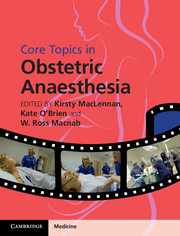Book contents
- Frontmatter
- Contents
- List of contributors
- Preface
- Section 1 Basic science, epidemiology and service organization
- Section 2 Obstetric aspects
- Section 3 Provision of anaesthesia
- Section 4 Medical conditions in pregnancy
- 14 Hypertension in pregnancy, pre-eclampsia and eclampsia
- 15 Sepsis and influenza in pregnancy
- 16 Cardiac disease in pregnancy
- 17 Respiratory disease in pregnancy
- 18 Obesity and ultrasonography for central neuraxial blocks
- 19 Endocrine disease in pregnancy including diabetes mellitus, thyroid and adrenal disease
- 20 Renal disease
- 21 Haematologic disease in pregnancy
- 22 Neurosurgical and neurological disease in pregnancy
- 23 Immunology, including testing and management of allergy during pregnancy
- 24 HIV and infectious disease in pregnancy, including herpes, syphilis and hepatitis
- Section 5 Postpartum complications and obstetric emergencies
- Section 6 Service organization
- Index
- Plate section
- References
14 - Hypertension in pregnancy, pre-eclampsia and eclampsia
from Section 4 - Medical conditions in pregnancy
Published online by Cambridge University Press: 05 December 2015
- Frontmatter
- Contents
- List of contributors
- Preface
- Section 1 Basic science, epidemiology and service organization
- Section 2 Obstetric aspects
- Section 3 Provision of anaesthesia
- Section 4 Medical conditions in pregnancy
- 14 Hypertension in pregnancy, pre-eclampsia and eclampsia
- 15 Sepsis and influenza in pregnancy
- 16 Cardiac disease in pregnancy
- 17 Respiratory disease in pregnancy
- 18 Obesity and ultrasonography for central neuraxial blocks
- 19 Endocrine disease in pregnancy including diabetes mellitus, thyroid and adrenal disease
- 20 Renal disease
- 21 Haematologic disease in pregnancy
- 22 Neurosurgical and neurological disease in pregnancy
- 23 Immunology, including testing and management of allergy during pregnancy
- 24 HIV and infectious disease in pregnancy, including herpes, syphilis and hepatitis
- Section 5 Postpartum complications and obstetric emergencies
- Section 6 Service organization
- Index
- Plate section
- References
Summary
Introduction
Hypertensive disorders of pregnancy are one of the most common antenatal complications, affecting 3–4% of all pregnancies:
• They are a leading cause of direct maternal death in the UK and USA, with a rate of 0.83 and 0.99 per 100,000 maternities respectively
• The necessity for urgent treatment of systolic hypertension (>160 mmHg) was one of the top ten recommendations in the last Maternal Mortality Report (CMACE 2006–2008):
• There were seven deaths associated with inadequate control of systolic hypertension resulting in cerebral haemorrhage
• Women with severe pre-eclampsia need to be managed by an effective multidisciplinary team
• There is fetal morbidity and mortality associated with pre-eclampsia:
• Iatrogenic preterm delivery
• Fetal death in utero and stillbirth
• Fetal growth restriction
• There is also growing evidence of increased long term health risks in:
• Women who have had pre-eclamptic pregnancies, including cardiovascular disease, type 2 diabetes mellitus and metabolic syndrome
• Children of pre-eclamptic mothers also have an increased risk of hypertension and metabolic syndrome in later life.
Classification of hypertension in pregnancy
Hypertension in pregnancy is categorized according to gestation and cause (see Table 14.1). Before 20 weeks, it is likely to be due to chronic, pre-existing hypertension. Hypertension is often identified for the first time in early pregnancy and it is important to rule out any secondary causes. The commonest secondary cause is renal disease, but it is important to exclude vascular, endocrine and immunological causes. Approximately 20% of women with chronic hypertension will go on to develop superimposed pre-eclampsia.
Gestational hypertension complicates 10% of pregnancies and is defined as new-onset hypertension (>140/90 mmHg) after 20 weeks, without significant proteinuria or other features suggestive of multisystem disease.
Pre-eclampsia affects 3–4% of pregnancies, and is defined as new-onset hypertension with significant proteinuria: greater than 300 mg of urinary protein in 24 hours or a urinary protein:creatinine ratio (uPCR) > 30 mg/mmol.
Pre-eclampsia can occur at any time after 20 weeks’ gestation, even into the postpartum period. Early-onset pre-eclampsia (<34/40) represents around 30% of cases and is often associated with more severe fetal compromise. Severe maternal disease can develop at any gestation. The only cure for the condition is delivery of the placenta.
- Type
- Chapter
- Information
- Core Topics in Obstetric Anaesthesia , pp. 97 - 104Publisher: Cambridge University PressPrint publication year: 2015



